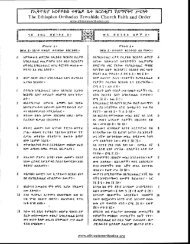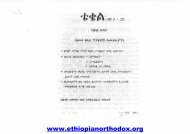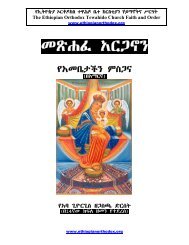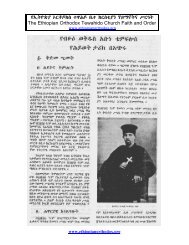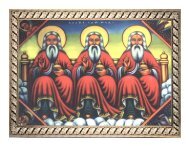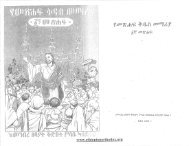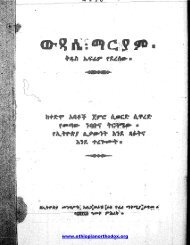Touch me not - The Ethiopian Orthodox Tewahedo Church
Touch me not - The Ethiopian Orthodox Tewahedo Church
Touch me not - The Ethiopian Orthodox Tewahedo Church
Create successful ePaper yourself
Turn your PDF publications into a flip-book with our unique Google optimized e-Paper software.
<strong>The</strong> <strong>Ethiopian</strong> <strong>Orthodox</strong> Tewahido <strong>Church</strong> Faith and Order<br />
www.ethiopianorthodox.org<br />
<strong>Touch</strong> <strong>me</strong> <strong>not</strong>; for I am <strong>not</strong> yet ascended to my Father<br />
So<strong>me</strong> people have been asking why did Jesus say to Mary Magdalene, “<strong>Touch</strong> <strong>me</strong> <strong>not</strong>; for I am <strong>not</strong><br />
yet ascended to my Father” but, allowed Thomas to do so. Different people have interpreted this<br />
verse variously. What does this verse really <strong>me</strong>an? This verse is found in the Gospel according to St.<br />
John, chapter 20, verse 17. And its states, “Jesus saith unto her, <strong>Touch</strong> <strong>me</strong> <strong>not</strong>; for I am <strong>not</strong> yet<br />
ascended to my Father: But go to my brethren, and say unto them, I ascend unto my Father, and your<br />
Father; and to my God, and your God. Mary Magdalene ca<strong>me</strong> and told the disciples that she had<br />
seen the Lord, and that he had spoken these things unto her.”<br />
So, why did John quote Jesus as having said, “<strong>Touch</strong> <strong>me</strong> <strong>not</strong>; for I am <strong>not</strong> yet ascended to my<br />
Father”? Should this be understood to <strong>me</strong>an that Mary Magdalene wasn’t allowed to touch Christ<br />
after His resurrection? To properly interpret this, it is important to realize that, as is frequently the<br />
case, John’s account offers a unique perspective on the event. His take offers more about what<br />
Christ sees in a person’s heart, rather than the synoptic accounts of sense perception. Compare<br />
John’s version with St. Matthew’s (28:9-10): “... Jesus <strong>me</strong>t them, saying, All hail. And they ca<strong>me</strong><br />
and held him by the feet, and worshipped him. <strong>The</strong>n said Jesus unto them, ‘Be <strong>not</strong> afraid: go tell my<br />
brethren that they go into Galilee, and there shall they see <strong>me</strong>.’”<br />
St. John’s coverage of Christ’s initial appearance to St. Mary Magdalene might be better understood<br />
by reading the following paraphrase. Since you already believe that it is I, speaking to you, and that I<br />
have arisen, be assured that I will be around for a while, so that we may talk further. But, now, your<br />
assign<strong>me</strong>nt is to go and tell my brethren about my resurrection from the dead. Otherwise, this Bible<br />
citation is apt to be misinterpreted as <strong>me</strong>aning that she (a woman) should <strong>not</strong> touch Him after His<br />
resurrection and before His ascension. All the Gospels confirm Mary Magdalene to have been the<br />
first one to see Jesus after His resurrection. If the real issue had been that she wasn’t good enough to<br />
touch Him, Christ would have shown Himself to one or more of His disciples. It does <strong>not</strong> make<br />
sense to suppose wo<strong>me</strong>n who discovered His resurrection before the rest of His followers; weren’t<br />
allowed to touch Him. Because Mary Magdalene had told the disciples the good news, she is known<br />
both as the apostle to the apostles, and as an equal to the apostles.<br />
In a<strong>not</strong>her instance, Jesus invited Thomas to touch him. Thus, he, who had <strong>not</strong> been with the other<br />
disciples when Jesus appeared earlier, might realize our Lord knew what was in his heart, even while<br />
he yet doubted. In the sa<strong>me</strong> chapter, John reported “<strong>The</strong> other disciples, therefore; said unto him,<br />
‘We have seen the Lord.’ But he said unto them, ‘Except I shall see in his hands the print of the<br />
nails, and put my finger into the print of the nails, and thrust my hand into his side, I will <strong>not</strong><br />
believe.’ On the eighth day after the resurrection while the doors were shut, Jesus appeared again in<br />
the midst of His disciples and this ti<strong>me</strong> Thomas was in the house. Jesus said to them ‘Peace be unto<br />
you’”. Since there is <strong>not</strong>hing hidden from Our Lord Jesus Christ, He knew what Thomas had told<br />
the other disciples. And that is why after He greeted them said to Thomas, “Reach hither thy finger,<br />
and behold my hands; and reach hither thy hand, and thrust it into my side: and be <strong>not</strong> faithless, but<br />
believing (John 20:25). Reread the whole thing carefully. Note, this Gospel does <strong>not</strong> indicate
<strong>The</strong> <strong>Ethiopian</strong> <strong>Orthodox</strong> Tewahido <strong>Church</strong> Faith and Order<br />
www.ethiopianorthodox.org<br />
whether or <strong>not</strong> Thomas touched our Lord. Instead, it records his faith state<strong>me</strong>nt, “My Lord and my<br />
God.”<br />
<strong>The</strong>refore, by comparing the above citations, we should learn that Christ desires all, including us,<br />
who have <strong>not</strong> seen what they saw, to receive the blessings of belief, rather than remaining faithless.<br />
We should appreciate Christ’s sensitivity to individual needs, in receiving the seed of faith, rather<br />
than gender differentiation, preferring that only <strong>me</strong>n (the disciples) should touch Him after His<br />
resurrection.<br />
Beide-Mariam Ejigu Retta<br />
June 2009



